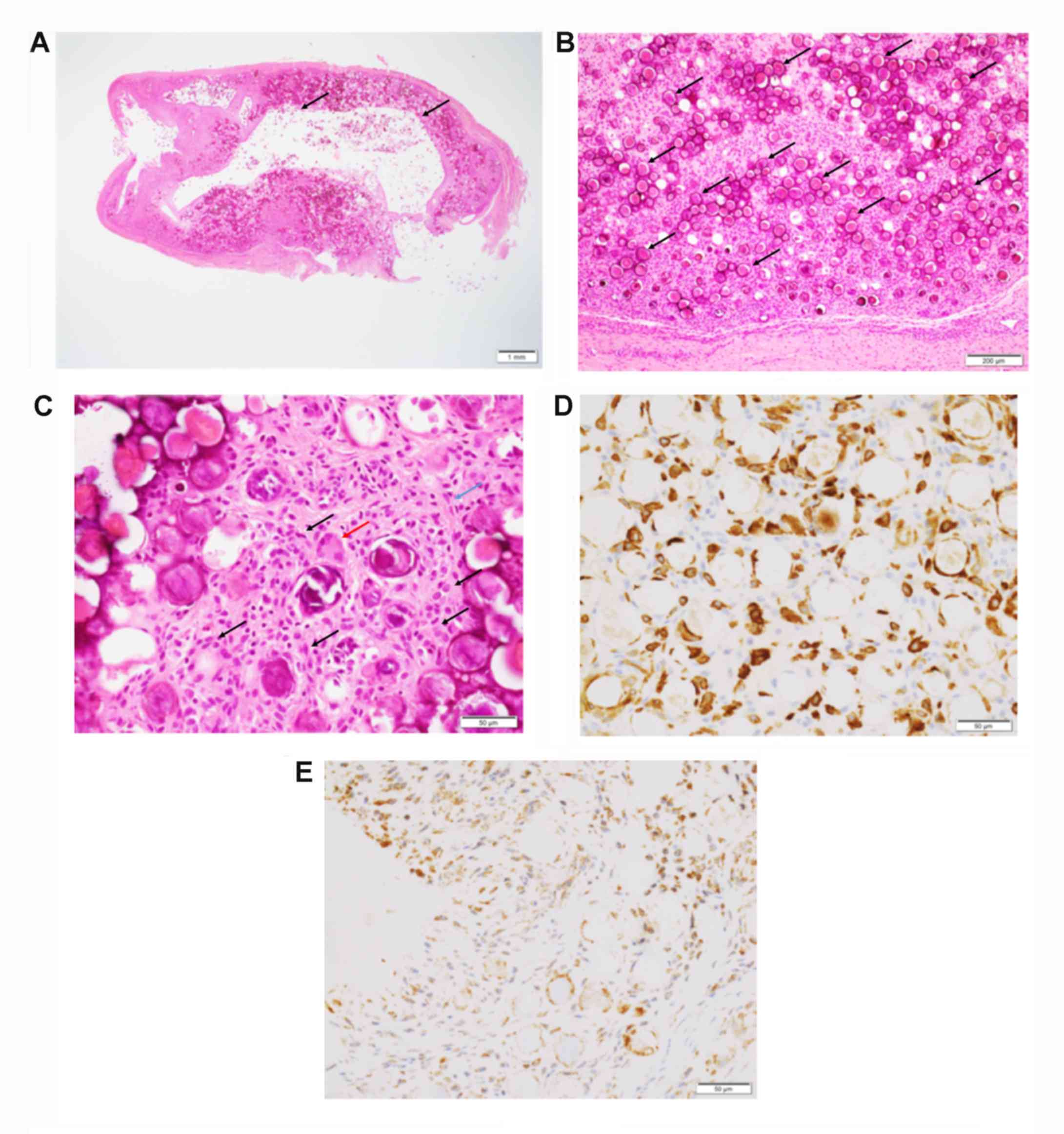Immunohistochemical analyses to determine pathogenesis of tenosynovitis with psammomatous calcification in the wrist: A case report
- Authors:
- Chika Miyasaka
- Mitsuaki Ishida
- Yoshitaka Hamada
- Takeyasu Toyama
- Koji Tsuta
View Affiliations
Affiliations: Department of Pathology and Laboratory Medicine, Kansai Medical University, Hirakata, Osaka 573‑1010, Japan, Department of Orthopedic Surgery, Kansai Medical University, Hirakata, Osaka 573‑1010, Japan
- Published online on: May 31, 2019 https://doi.org/10.3892/br.2019.1218
-
Pages:
27-30
Metrics: Total
Views: 0 (Spandidos Publications: | PMC Statistics: )
Metrics: Total PDF Downloads: 0 (Spandidos Publications: | PMC Statistics: )
This article is mentioned in:
Abstract
Tenosynovitis with psammomatous calcification is an extremely rare clinicopathological condition, which is characterized histopathologically by the presence of numerous psammomatous calcifications surrounded by a granulomatous reaction comprising a mixture of histiocytes and fibroblasts. The pathogenesis of this disease remains unclear, although an association with repetitive tendinous injury has been proposed. The present study describes the details of a case in an elderly Japanese female, and, to the best of our knowledge, the first known immunohistochemical analysis of the mechanism underlying psammomatous calcification formation. A 66‑year‑old Japanese woman presented with pain in the right wrist. The lesion was surgically resected. Histopathological examination revealed a well‑circumscribed lesion composed of psammomatous calcification. The calcification was surrounded by histiocytes, and a few multinucleated giant cells and fibroblastic spindle cells. Immunohistochemical study revealed that these histiocytes were positive for cluster of differentiation 163, and the histiocytes and spindle cells surrounding the psammomatous calcification expressed bone morphogenetic protein‑1 (BMP‑1). Tenosynovitis with psammomatous calcification is hypothesized to be a distinctive subtype of idiopathic calcifying tenosynovitis involving an unusual reactive or degenerative process. BMP‑1 has been demonstrated to be involved in the regulation of hard tissue mineralization, and its expression has been suggested to be associated with psammoma formation in papillary thyroid cancer. To the best of our knowledge, the case report within the present study suggested for the first time that BMP‑1 expression was associated with development of psammomatous calcification in this condition.
View References
|
1
|
Gravanis MB and Gaffney EF: Idiopathic
calcifying tenosynovitis. Histopathologic features and possible
pathogenesis. Am J Surg Pathol. 7:357–361. 1983.PubMed/NCBI
|
|
2
|
Shon W and Folpe AL: Tenosynovitis with
psammomatous calcification: A poorly recognized pseudotumor related
to repetitive tendinous injury. Am J Surg Pathol. 34:892–895.
2010.PubMed/NCBI View Article : Google Scholar
|
|
3
|
Robb T, Kimberly O, Strutton GM and
McAuliffe M: Tenosynovitis with psammomatous calcification of the
knee. Pathology. 44:369–370. 2012.PubMed/NCBI View Article : Google Scholar
|
|
4
|
Kawata M, Seki K and Miura T:
Tenosynovitis with psammomatous calcification arising from the
volar plate of the proximal interphalangeal joint of the finger.
Pathol Int. 64:539–541. 2014.PubMed/NCBI View Article : Google Scholar
|
|
5
|
Fox MP, McKay JE, Craver RD and Pappas ND:
Right ring finger volar mass in a 14-year-old boy. Orthopedics.
40:e918–e920. 2017.PubMed/NCBI View Article : Google Scholar
|
|
6
|
Michal M, Agaimy A, Folpe AL, Zambo I,
Kebrle R, Horch RE, Kinkor Z, Svajdler M, Vanecek T, Heidenreich F,
et al: Tenosynovitis with psammomatous calcifications: A
distinctive trauma-associated subtype of idiopathic calcifying
tenosynovitis with a predilection for the distal extremities of
middle-aged women-A report of 23 cases. Am J Surg Pathol.
43:261–267. 2019.PubMed/NCBI View Article : Google Scholar
|
|
7
|
Vadon-Le Goff S, Hulmes DJ and Moali C:
BMP-1/tolloid-like proteinases synchronize matrix assembly with
growth factor activation to promote morphogenesis and tissue
remodeling. Matrix Biol. 44-46:14–23. 2015.PubMed/NCBI View Article : Google Scholar
|
|
8
|
Liu K, Tripp S and Layfield LJ:
Heterotopic ossification: Review of histologic findings and tissue
distribution in a 10-year experience. Pathol Res Pract.
203:633–640. 2007.PubMed/NCBI View Article : Google Scholar
|
|
9
|
Bai Y, Zhou G, Nakamura M, Ozaki T, Mori
I, Taniguchi E, Miyauchi A, Ito Y and Kakudo K: Survival impact of
psammoma body, stromal calcification, and bone formation in
papillary thyroid carcinoma. Mod Pathol. 22:887–894.
2009.PubMed/NCBI View Article : Google Scholar
|










